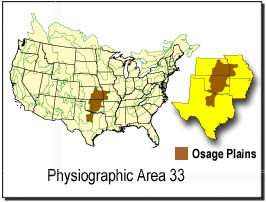Osage Plains facts for kids

The Osage Plains are a large area of tallgrass prairie in the central United States. This region is sometimes called the Lower Plains, North Central Plains, or Rolling Plains. It stretches across parts of Missouri, Kansas, Oklahoma, and northern Texas. It's a special place known for its wide-open spaces and unique plant and animal life.
Contents
What are the Osage Plains?
The Osage Plains are a type of ecosystem where grasses are the main kind of plant. Unlike forests with many trees, prairies are mostly covered in tall grasses. This area is part of a much larger region called the Central Lowland. It's known for its gently rolling hills, not flat land, but not mountains either.
Where are the Osage Plains located?
This prairie region covers a big part of the central U.S. You can find it in:
The plains are a transition zone between the very flat Great Plains to the west and the more hilly, forested areas to the east.
Life in the Osage Plains
The Osage Plains are home to many different kinds of plants and animals. The rich soil and moderate rainfall make it a great place for life to thrive.
Plants of the Prairie
The most common plants here are tall grasses. These can grow very high, sometimes taller than a person! Some important grasses include:
- Big bluestem
- Switchgrass
- Indiangrass
Besides grasses, you can also find many wildflowers. These add beautiful colors to the prairie, especially in spring and summer. Examples include coneflowers and prairie clovers.
Animals of the Osage Plains
Many animals call the Osage Plains home. Some of them are:
- Bison: Once, huge herds of bison roamed these plains. They are a symbol of the American prairie.
- Deer: White-tailed deer are common in the area.
- Coyotes: These clever animals are often seen hunting small prey.
- Birds: Many bird species live here, like the greater prairie chicken and various types of sparrows.
- Small mammals: You might also find prairie dogs, rabbits, and various rodents.
Why are prairies important?
Prairies like the Osage Plains are very important for several reasons:
- Biodiversity: They support a wide variety of plants and animals.
- Soil health: The deep roots of prairie grasses help create rich, healthy soil.
- Water filtration: Prairies help filter water as it soaks into the ground.
- Carbon storage: They store carbon in their soil, which helps with climate balance.
History of the Osage Plains
For thousands of years, Native American tribes lived in the Osage Plains. They hunted bison and used the land for their homes. Later, European settlers arrived, and much of the prairie was turned into farmland.
The Osage Nation
The Osage Plains are named after the Osage Nation, a Native American tribe. They traditionally lived in this area. The Osage people were known for their hunting and farming skills. They had a deep connection to the land and its resources.
Challenges and Conservation
Today, much of the original tallgrass prairie is gone. It has been replaced by farms and towns. However, there are efforts to protect and restore what remains.
Protecting the Prairie
Conservation groups and scientists are working hard to save the Osage Plains. They are trying to:
- Protect existing prairie lands.
- Restore areas that have been damaged.
- Educate people about the importance of prairies.
These efforts help ensure that future generations can also enjoy the beauty and importance of this unique ecosystem.

